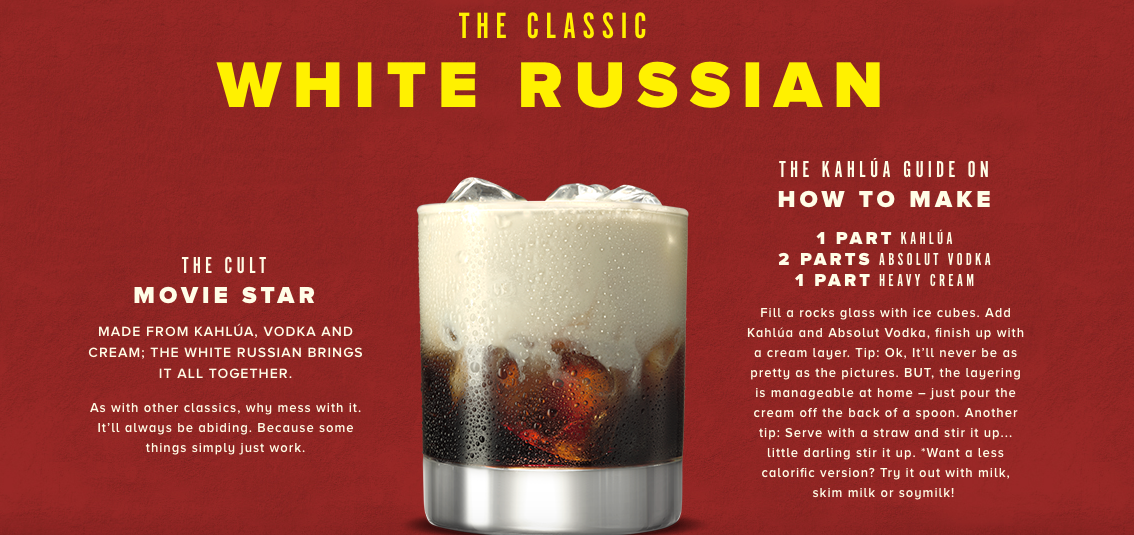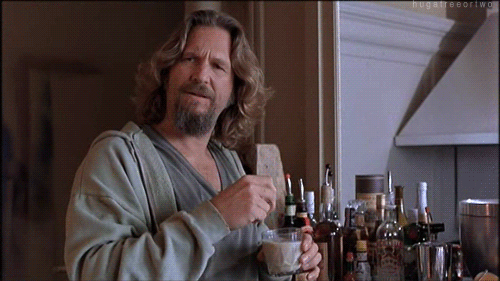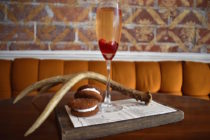This article (below) originally appeared in the December 2013 – January 2014 print issue (#118) of My Table magazine. In honor of Big Lebowski Day, we’re bringing it back.
We are in the midst of a glorious cocktail Renaissance.
Researchers into the cocktails served to our venerable ancestors have appeared and written books, mixologists such as Dale DeGroff and Ted Haigh. Then there are masters in recreating ancient tipples, such as Ted Breaux, who used his skills as a chemist and environmental microbiologist and the technology of the spectrometer to recreate the absinthe of decades past.
The cocktails they have revived are indeed wonderful. They fuel the current interest in quality cocktails. But do they cover all of this vast territory of mixology with equal vigor?
Greek wine specialist Evan Turner opines that “Bitter is what’s happening now.” And indeed, it is. But what about the sweet dessert cocktails of years past?
These were the naughty drinks served after dinner to guests in John Updike’s novel Couples, one could imagine. A little something that did not taste of alcohol, as the cocktails of the F. Scott Fitzgerald generation often did. Cocktails one could picture Debbie Reynolds sipping while dining in the apartment of an unrepentant bachelor dog like Cary Grant. Synthetically colorful, sweetly flavorful and full of indecent intent.
It is difficult to accurately date the emergence of the dessert cocktail. A bar in Milwaukee, Wisconsin, claims to have originated the Pink Squirrel cocktail there some time after the bar opened in 1938.
The essential ingredients of dessert cocktails seem to be the liqueurs developed by the Dutch firm of Bols. The company dates its founding to 1575, making it one of the most venerable distilleries in the world. By the 1960s the firm was producing a variety of unusually flavored and colored liqueurs. Today the successor firm, having gone through several changes of ownership, produces 38 flavors, including green tea, lychee, pomegranate and kiwi. Many of them are highly colored, making cocktails like the Pink Squirrel possible.
Certainly without the almond-flavored, shockingly red-dyed Bols liqueur sold as Crème de Noyaux, the Pink Squirrel would not be possible. And if it would not be possible, a little light would go out in my life. There is nothing like a martini glass filled with a foamy, pastel Pepto-Bismol-colored liquid to say the Unserious Hour has arrived at a dinner party in my home.
Like many good traditional cocktails, the dessert cocktail consists of a trio of flavors. There is a highly flavored liqueur, a distilled spirit and either cream or half-and-half.
The dessert cocktail that has survived into the present most successfully is the White Russian. This is in no small part to the credit of Joel and Ethan Coen, who in creating the character of The Dude in their classic film opus, The Big Lebowski, created a thirst for this classic dessert cocktail.
The Dude (played by Jeff Bridges) drinks a total of eight White Russians in the course of the movie, and the film’s makers use the beverage choice to communicate an important aspect of his personality. The drink is alcoholic, but its flavor brings to mind a children’s favorite, chocolate milk. It is fairly bland, fairly simple, sweet and comforting. Which is both why the drink enjoyed such a revival after the film was released in 1998 – and probably why dessert cocktails are so under-represented in the current classic cocktail revival.
In Houston today, there are several bars (and one hamburger emporium, Little Big’s) that offer interesting takes on the classic White Russian.
At Prohibition, bar manager Rusty Lovell mixed me a White Bison, which uses Polish Żubrówka vodka in place of the usual plain vodka. Żubrówka is a Polish vodka infused with blades of a grass that is the favored graze of the European bison Hierochloe odorata and contains small amounts of the blood-thinning agent coumarin. Consequently, the FDA has banned it since 1978, and the Żubrówka available in the United States has been cleansed of this substance. However, the wonderful sweet grass flavor remains in the cocktail. In Native American culture the same plant is used in various ceremonies. Thus, we have a dessert cocktail that allows you to venerate the Great Spirit while you imbibe a great spirit. Not a bad turn.
At Little Big’s, a pleasant Kahlua-laced milkshake – but without the cocktail’s vodka – named The Dude is served.
My intense research for dessert cocktails took me, after a visit to a number of bars and after perusing certain parchment documents and codices in the libraries of the Rice Institute, back to a wonderful Mad Men-era set of desserts. (The only bar that could satisfy my cocktail requirements was old-school Warren’s on Market Square, where bartendress Ally, of the great arm tattoos, made me a classic Grasshopper.)
I had assumed that the dessert cocktail pie belonged to an era BC – that is, Before [Julia] Child. Back then, Americans, while drinking enthusiastically, were chary of alcoholic liquids in their food. It was assumed that using wine or Cognac in a recipe was something that only a Hathaway shirt model lady-killer (in real life, the Russian Baron George Wrangell, who had 20/20 vision and did not need an eye patch) would use. Cook a boeuf bourguignon, the myth went, and the proper young lady from a Heavenly Seven college you were serving dinner to in your Manhattan lair would rip off her twin set and walk down Park Avenue in her Maidenform bra. Well, in reality, the heat cooked the alcohol out. And those girls were altogether too sharp for such a ploy – plus they could drink.
I decided to make one of the cordial pies Amanda Hesser resurrected in The New York Times in 2006. The pies originally appeared in the Times in 1975, an era of ghastly taste in clothes, music and pretty much everything else. But the pies seemed fun. The Pink Squirrel pie seemed especially fun. Perhaps that is because I have a number of dogs, and the word “squirrel” sets things awhirl in my house. Or, maybe it is because of the word “pink,” which suggests frivolity.
The basic formula suggested by Dick Taeuber, the man Hesser quoted in her story, is three eggs to one cup of heavy cream to one-half cup of liquor. There are other ingredients necessary, such as gelatin. You can access them on The New York Times website under “Dick Taeuber’s Cordial Pie,” which contains 20 variations. The crust can be crushed graham crackers, chocolate cookies or gingersnaps. Or you name it.
The Pink Squirrel pie was all that I could hope for, in a Pink Squirrel pie.
But, the question remained: Will the current cocktail revolution ever turn towards making really inventive, interesting, adult, stimulating … dessert cocktails?
I decided to pay a call upon one of Houston’s most distinguished mixologists, Chris Frankel at RDG + BarAnnie, otherwise known to old-time Houstonians as Cafe Annie. Frankel, a 2006 Princeton graduate, is the bar manager and a mixologist. I put the question to him: “Is there a future for the dessert cocktail?”
Frankel admitted that he had been thinking upon the selfsame theme. After some discourse, he produced a new cocktail. He did not have a name for it that evening but subsequently let me know he was calling it Winter Dreams after the nickname of a Tchaikovsky composition. He has promised to put it on the bar’s menu for the winter season.
Here are the ingredients, as Frankel wrote them down for me:
1 oz. half & half
1 oz. Barack Palinka
1 oz. Olorosso Sherry
½ oz. homemade grenadine
½ oz. green Chartreuse
METHOD: Shake, strain into a Champagne flute. Garnish with a sprig of tarragon.
Palinka is a clear liquor in the eau-de-vie family, made in Hungary from apricots. It is one of the loveliest things in the drinking universe and little known in the United States at this time.
For homemade grenadine you should use pomegranates, sugar and water. The most common commercial grenadine, Rose’s, has no relation to the pomegranate fruit, being made of high fructose corn syrup, water, citric acid, sodium citrate, sodium benzoate, FD&C Red #40, natural and artificial flavors, and FD&C Blue #1. So don’t go near it for this elixir.
And then there’s the scent of the fresh tarragon, an herb brought to France by the Arabs from the Russian steppes. Tarragon has not been in any cocktail I have ever tried before, but it has a quality similar to the wonderful scent of the buffalo grass in the Prohibition bar’s White Bison and thus makes sense here.
Then, though, there is the Chartreuse. The British writer H. H. Munro, a favorite author of my youth, has a character in one of his short stories declare that “people may say what they like about the decay of Christianity; the religious system that produced green Chartreuse can never really die.” It is made from some 130 herbs by monks who have taken a vow of perpetual silence and live in one of the remotest valleys of the French Alps. Or it used to be. Now the monks have a plant in the nearby town of Voiron.
It was Frankel’s addition of the Chartreuse, which counts wormwood among its ingredients, that gave this libation that saving grace note of bitterness.
So Evan Turner was right. Bitterness is the thing, even in a dessert cocktail.








Follow Us